View in other NatureServe Network Field Guides
NatureServe
Montana
Utah
Wyoming
Idaho
Wisconsin
British Columbia
South Carolina
Yukon
California
New York
Western Tiger Swallowtail - Pterourus rutulus
Native Species
Global Rank:
G5
State Rank:
S5
Agency Status
USFWS:
USFS:
BLM:
External Links
General Description
[From Ferris and Brown 1981; Scott 1986; Opler and Wright 1999; Glassberg 2001; Pyle 2002] Forewing 4.6-5.5 cm. Single-tailed. Uppersurface pale to bright yellow with medium to broad black border and tiger stripes; hindwing with uppermost marginal spot yellow or absent (never orange), other marginal crescents yellow, red-orange crescents at inner angle near tail. Undersurface of forewing with more-or-less continuous yellow marginal band, hindwing marginal spots narrow, submarginal metallic blue zones expanded, postmedian area without orange infusion.
Phenology
One flight, June to July (Ferris and Brown 1981; Scott 1986). Mainly June to July , but March to October in Pacific lowlands (Glassberg 2001). Late May to late August in Colorado (Emmel 1964; Scott and Scott 1978; Scott and Epstein 1987), mid-April to late September in Oregon and Washington (Pyle 2002), mid-April to mid-August in Oregon (Warren 2005), late May to August in British Columbia (Guppy and Shepard 2001).
Diagnostic Characteristics
Best determined by a combination of yellow base color, hindwing with single tail, uppersurface of hindwing with uppermost marginal spot yellow or absent (never orange), undersurface of forewing with more-or-less continuous yellow marginal band.
Species Range
Montana Range
Range Descriptions
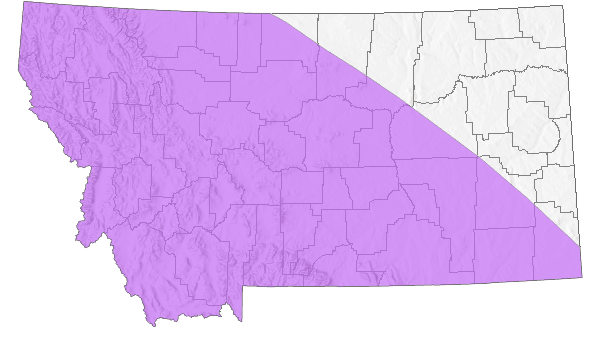
 Native
Native
Range Comments
Southern British Columbia south through western US to northern Baja California and southern New Mexico, east to western South Dakota (Black Hills) and southeastern Colorado (Scott 1986; Opler and Wright 1999; Glassberg 2001); 1829 m to 3048 m elevation in the Rocky Mountain states (Ferris and Brown 1981), 1463 m to 3181 m elevation in Colorado (Brown 1957; Scott and Scott 1978), sea level to at least 2195 m elevation in Oregon and Washington (Warren 2005; James and Nunnallee 2011), to at least 1300 m elevation in southeastern British Columbia (Threatful 1988). In Montana, reported from at least 34 counties, mostly in the western 2/3 of the state, east in the north to Valley County, in the south to Carter County (Kohler 1980; Stanford and Opler 1993; FLMNH Lepidopterists' Society database), to at least 1555 m elevation. Mainly common (Glassberg 2001).
Observations in Montana Natural Heritage Program Database
Number of Observations: 161
(Click on the following maps and charts to see full sized version)
Map Help and Descriptions
Relative Density
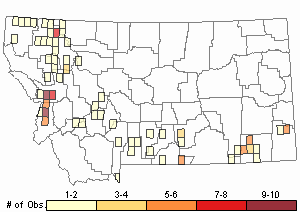
Recency
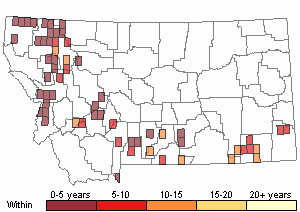
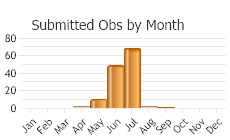
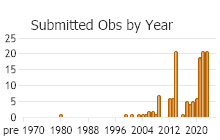
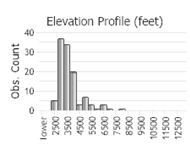 (Observations spanning multiple months or years are excluded from time charts)
(Observations spanning multiple months or years are excluded from time charts)
Migration
Non-migratory.
Habitat
Riparian woodlands, wet montane meadows, wooded suburbs, parks and gardens, canyon streams (Emmel 1964; Ferris and Brown 1981; Opler and Wright 1999; Glassberg 2001; Guppy and Shepard 2001; Pyle 2002). In Glacier National Park, Montana reported from mesic montane meadows and above treeline in alpine terrain (Debinski 1993); in the Greater Yellowstone Ecosystem reported from many habitats near moisture and tundra-edge deciduous woods (Debinski and Pritchard 2002).
Food Habits
Larval food plants are native and exotic trees and shrubs, including members of the Rosaceae (Malus, Prunus (several species), Rubus), Salicaceae (Populus (several species), Salix (several species)), Betulaceae (Alnus (several species), Betula), Aceraceae (Acer), Ulmaceae (Ulmus), Platanaceae (Platanus), Lauraceae (Persea), Oleaceae (Fraxinus, Ligustrum, Syringa), Rutaceae (Ptelea), and Fagaceae (Quercus) (Emmel et al. 1970; Scott 1986, 1992, 2006; Guppy and Shepard 2001; Graves and Shapiro 2003; Warren 2005). Adults feed on flower nectar (including Achillea, Agastache, Apocynum, Aquilegia, Asclepias, Balsamorhiza, Campanula, Carduus, Ceanothus, Chaenomeles, Cirsium, Coreopsis, Delphinium, Dianthus, Dipsacus, Echinacea, Eriodictyon, Eriogonum, Helianthella, Helianthus, Hesperis, Jamesia, Leontodon, Liatris, Lilium, Medicago, Nepeta, Oxytropis, Paeonia, Philadelphis, Phlox, Potentilla, Prunus, Purshia, Rhododendron, Rubus, Rudbeckia, Syringa, Tilia, Verbena), carrion, and mud (Scott 1986, 2014; Pyle 2002).
Reproductive Characteristics
Females lay eggs singly on upper surface of host plant leaf (Scott 1986, 1992, 2006; Guppy and Shepard 2001; James and Nunnallee 2011). Eggs per ovariole (1/8 total number) about 70 (Ehrlich and Ehrlich 1978). Eggs hatch in about 6-10 days, develop from L1 instar to L4 or L5 instar and pupae in about about 43-56 days, depending on temperature and food supply quality. Larvae solitary, feed on host plant leaves, spin thin silken pad on leaf surface on which to rest when not feeding (the silk mat draws the leaf into a gentle concave shape), wander as mature larvae prior to pupation, pupate on ground in litter, overwinter (diapause) as pupae, adults eclose (emerge from pupa) early the following spring (Scott 1979, 1986; Guppy and Shepard 2001; James and Nunnallee 2011). Males patrol or perch throughout the day on hilltops, along streams, woodland edges, other barriers, in search of females (Scott 1975b, 1986; Guppy and Shepard 2001; Pyle 2002; James and Nunnallee 2011).
Stewardship Responsibility
References
- Literature Cited AboveLegend:
 View Online Publication
View Online Publication Brown, F.M. 1957. Colorado Butterflies. Proceedings; Numbers Three through Seven. Denver Museum of Natural History, Denver, Co.
Brown, F.M. 1957. Colorado Butterflies. Proceedings; Numbers Three through Seven. Denver Museum of Natural History, Denver, Co. Debinski, D. 1993. Butterflies of Glacier National Park, Montana. Occasional Papers of the Museum of Natural History, the University of Kansas, Lawrence, Kansas. No. 159: 1-13.
Debinski, D. 1993. Butterflies of Glacier National Park, Montana. Occasional Papers of the Museum of Natural History, the University of Kansas, Lawrence, Kansas. No. 159: 1-13. Debinski, D.M. and J.A. Pritchard. 2002. A field guide to the butterflies of the Greater Yellowstone Ecosystem. Lanham, MD: Roberts Rinehart Publishers. 107 p.
Debinski, D.M. and J.A. Pritchard. 2002. A field guide to the butterflies of the Greater Yellowstone Ecosystem. Lanham, MD: Roberts Rinehart Publishers. 107 p. Ehrlich, A.H. and P.R. Ehrlich. 1978. Reproductive strategies in the butterflies: I. Mating frequency, plugging, and egg number. Journal of the Kansas Entomological Society 51(4): 666-697.
Ehrlich, A.H. and P.R. Ehrlich. 1978. Reproductive strategies in the butterflies: I. Mating frequency, plugging, and egg number. Journal of the Kansas Entomological Society 51(4): 666-697. Emmel, J.F., O. Shields, and D.E. Breedlove. 1970. Larval foodplant records for North American Rhopalocera Part 2. Journal of Research on the Lepidoptera 9(4): 233-242.
Emmel, J.F., O. Shields, and D.E. Breedlove. 1970. Larval foodplant records for North American Rhopalocera Part 2. Journal of Research on the Lepidoptera 9(4): 233-242. Emmel, T.C. 1964. The ecology and distribution of butterflies in a montane community near Florissant, Colorado. American Midland Naturalist 72(2): 358-373.
Emmel, T.C. 1964. The ecology and distribution of butterflies in a montane community near Florissant, Colorado. American Midland Naturalist 72(2): 358-373. Ferris, C.D. and F.M. Brown (eds). 1981. Butterflies of the Rocky Mountains. Univ. of Oklahoma Press. Norman. 442 pp.
Ferris, C.D. and F.M. Brown (eds). 1981. Butterflies of the Rocky Mountains. Univ. of Oklahoma Press. Norman. 442 pp. Glassberg, J. 2001. Butterflies through Binoculars: A Field Guide to the Butterflies of Western North America. Oxford University Press.
Glassberg, J. 2001. Butterflies through Binoculars: A Field Guide to the Butterflies of Western North America. Oxford University Press. Graves, S.D. and A.M. Shapiro. 2003.Exotics as host plants of the California butterfly fauna. Biological Conservation 110: 413-433.
Graves, S.D. and A.M. Shapiro. 2003.Exotics as host plants of the California butterfly fauna. Biological Conservation 110: 413-433. Guppy, C.S. and J.H. Shepard. 2001. Butterflies of British Columbia: including western Alberta, southern Yukon, the Alaska Panhandle, Washington, northern Oregon, northern Idaho, northwestern Montana. UBC Press (Vancouver, BC) and Royal British Columbia Museum (Victoria, BC). 414 pp.
Guppy, C.S. and J.H. Shepard. 2001. Butterflies of British Columbia: including western Alberta, southern Yukon, the Alaska Panhandle, Washington, northern Oregon, northern Idaho, northwestern Montana. UBC Press (Vancouver, BC) and Royal British Columbia Museum (Victoria, BC). 414 pp. James, D.G. and D. Nunnallee. 2011. Life histories of Cascadia butterflies. Corvallis, OR: Oregon State University Press. 447 p.
James, D.G. and D. Nunnallee. 2011. Life histories of Cascadia butterflies. Corvallis, OR: Oregon State University Press. 447 p. Kohler, S. 1980. Checklist of Montana Butterflies (Rhopalocera). Journal of the Lepidopterists' Society 34(1): 1-19.
Kohler, S. 1980. Checklist of Montana Butterflies (Rhopalocera). Journal of the Lepidopterists' Society 34(1): 1-19. Opler, P.A. and A.B. Wright. 1999. A field guide to western butterflies. Second edition. Peterson Field Guides. Houghton Mifflin Company, Boston, Massachusetts. 540 pp.
Opler, P.A. and A.B. Wright. 1999. A field guide to western butterflies. Second edition. Peterson Field Guides. Houghton Mifflin Company, Boston, Massachusetts. 540 pp. Pyle, R.M. 2002. The butterflies of Cascadia: a field guide to all the species of Washington, Oregon, and surrounding territories. Seattle Audubon Society, Seattle, Washington. 420 pp.
Pyle, R.M. 2002. The butterflies of Cascadia: a field guide to all the species of Washington, Oregon, and surrounding territories. Seattle Audubon Society, Seattle, Washington. 420 pp. Scott, J.A. 1975b. Mate-locating behavior of western North American butterflies. Journal of Research on the Lepidoptera 14:1-40.
Scott, J.A. 1975b. Mate-locating behavior of western North American butterflies. Journal of Research on the Lepidoptera 14:1-40. Scott, J.A. 1979. Hibernal diapause of North American Papilionoidea and Hesperioidea. Journal of Research on the Lepidoptera 18(3): 171-200.
Scott, J.A. 1979. Hibernal diapause of North American Papilionoidea and Hesperioidea. Journal of Research on the Lepidoptera 18(3): 171-200. Scott, J.A. 1986. The butterflies of North America: a natural history and field guide. Stanford University Press, Stanford, California.
Scott, J.A. 1986. The butterflies of North America: a natural history and field guide. Stanford University Press, Stanford, California. Scott, J.A. 1992. Hostplant records for butterflies and skippers (mostly from Colorado) 1959-1992, with new life histories and notes on oviposition, immatures, and ecology. Papilio new series #6. 185 p.
Scott, J.A. 1992. Hostplant records for butterflies and skippers (mostly from Colorado) 1959-1992, with new life histories and notes on oviposition, immatures, and ecology. Papilio new series #6. 185 p. Scott, J.A. 2006. Butterfly hostplant records, 1992-2005, with a treatise on the evolution of Erynnis, and a note on new terminology for mate-locating behavior. Papilio new series #14. 74 p.
Scott, J.A. 2006. Butterfly hostplant records, 1992-2005, with a treatise on the evolution of Erynnis, and a note on new terminology for mate-locating behavior. Papilio new series #14. 74 p. Scott, J.A. 2014. Lepidoptera of North America 13. Flower visitation by Colorado butterflies (40,615 records) with a review of the literature on pollination of Colorado plants and butterfly attraction (Lepidoptera: Hersperioidea and Papilionoidea). Contributions of the C.P. Gillette Museum of Arthopod Diversity. Fort Collins, CO: Colorado State University. 190 p.
Scott, J.A. 2014. Lepidoptera of North America 13. Flower visitation by Colorado butterflies (40,615 records) with a review of the literature on pollination of Colorado plants and butterfly attraction (Lepidoptera: Hersperioidea and Papilionoidea). Contributions of the C.P. Gillette Museum of Arthopod Diversity. Fort Collins, CO: Colorado State University. 190 p. Scott, J.A. and G.R. Scott. 1978. Ecology and distribution of the butterflies of southern central Colorado. Journal of Research on the Lepidoptera 17(2): 73-128.
Scott, J.A. and G.R. Scott. 1978. Ecology and distribution of the butterflies of southern central Colorado. Journal of Research on the Lepidoptera 17(2): 73-128. Scott, J.A. and M.E. Epstein. 1987. Factors affecting phenology in a temperate insect community. American Midland Naturalist 117(1): 103-118.
Scott, J.A. and M.E. Epstein. 1987. Factors affecting phenology in a temperate insect community. American Midland Naturalist 117(1): 103-118. Stanford, R.E. and P.A. Opler. 1993. Atlas of western USA butterflies: including adjacent parts of Canada and Mexico. Unpubl. Report. Denver and Fort Collins, Colorado 275 pp.
Stanford, R.E. and P.A. Opler. 1993. Atlas of western USA butterflies: including adjacent parts of Canada and Mexico. Unpubl. Report. Denver and Fort Collins, Colorado 275 pp. Threatful, D.L. 1988. A list of the butterflies and skippers of Mount Revelstoke and Glacier National Parks, British Columbia, Canada (Lepidoptera). Journal of Research on the Lepidoptera 27(3-4): 213-221.
Threatful, D.L. 1988. A list of the butterflies and skippers of Mount Revelstoke and Glacier National Parks, British Columbia, Canada (Lepidoptera). Journal of Research on the Lepidoptera 27(3-4): 213-221. Warren, A.D. 2005. Lepidoptera of North America 6: Butterflies of Oregon, their taxonomy, distribution, and biology. Contributions of the C. P. Gillette Museum of Arthropod Diversity, Colorado State University. Fort Collins, Colorado. 406 pp.
Warren, A.D. 2005. Lepidoptera of North America 6: Butterflies of Oregon, their taxonomy, distribution, and biology. Contributions of the C. P. Gillette Museum of Arthropod Diversity, Colorado State University. Fort Collins, Colorado. 406 pp.
- Additional ReferencesLegend:
 View Online Publication
View Online Publication
Do you know of a citation we're missing? Allen, T.J., J.P. Brock, and J. Glassberg. 2005. Caterpillars in the field and garden: a field guide to the butterfly caterpillars of North America. Oxford University Press.
Allen, T.J., J.P. Brock, and J. Glassberg. 2005. Caterpillars in the field and garden: a field guide to the butterfly caterpillars of North America. Oxford University Press. Brock, J.P. and K. Kaufman. 2003. Kaufman Field Guide to Butterflies of North America. Houghton Mifflin Company, New York, NY 284 pp.
Brock, J.P. and K. Kaufman. 2003. Kaufman Field Guide to Butterflies of North America. Houghton Mifflin Company, New York, NY 284 pp. Caruthers, J.C., and D. Debinski. 2006. Montane meadow butterfly species distributions in the Greater Yellowstone Ecosystem. University of Wyoming National Park Service Research Center Annual Report, 2006. Vol. 30, Art. 14. 85-96.
Caruthers, J.C., and D. Debinski. 2006. Montane meadow butterfly species distributions in the Greater Yellowstone Ecosystem. University of Wyoming National Park Service Research Center Annual Report, 2006. Vol. 30, Art. 14. 85-96. Forister, M.L., C.A. Halsch, C.C. Nice, J.A. Fordyce, T.E. Dilts, J.C. Oliver, K.L. Prudic, A.M. Shapiro, J.K. Wilson, J. Glassberg. 2021. Fewer butterflies seen by community scientists across the warming and drying landscapes of the American West. Science 371:1042-1045.
Forister, M.L., C.A. Halsch, C.C. Nice, J.A. Fordyce, T.E. Dilts, J.C. Oliver, K.L. Prudic, A.M. Shapiro, J.K. Wilson, J. Glassberg. 2021. Fewer butterflies seen by community scientists across the warming and drying landscapes of the American West. Science 371:1042-1045. Forister, M.L., E.M. Grames, C.A. Halsch, K.J. Burls, C.F. Carroll, K.L. Bell, J.P. Jahner, et al. 2023. Assessing risk for butterflies in the context of climate change, demographic uncertainty, and heterogeneous data sources. Ecological Monographs 93(3):e1584. https://doi.org/10.1002/ecm.1584
Forister, M.L., E.M. Grames, C.A. Halsch, K.J. Burls, C.F. Carroll, K.L. Bell, J.P. Jahner, et al. 2023. Assessing risk for butterflies in the context of climate change, demographic uncertainty, and heterogeneous data sources. Ecological Monographs 93(3):e1584. https://doi.org/10.1002/ecm.1584 Layberry, R.A., P.W. Hall, and J.D. LaFontaine. 1998. The Butterflies of Canada. University of Toronto Press. 280 pp. + color plates.
Layberry, R.A., P.W. Hall, and J.D. LaFontaine. 1998. The Butterflies of Canada. University of Toronto Press. 280 pp. + color plates. Maxell, B.A. 2016. Northern Goshawk surveys on the Beartooth, Ashland, and Sioux Districts of the Custer-Gallatin National Forest: 2012-2014. Montana Natural Heritage Program. Helena, MT. 114pp.
Maxell, B.A. 2016. Northern Goshawk surveys on the Beartooth, Ashland, and Sioux Districts of the Custer-Gallatin National Forest: 2012-2014. Montana Natural Heritage Program. Helena, MT. 114pp.
- Web Search Engines for Articles on "Western Tiger Swallowtail"
- Additional Sources of Information Related to "Insects"





